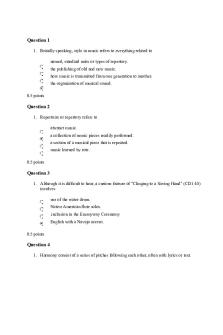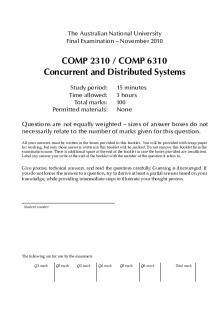Midterm 2010 PDF

| Title | Midterm 2010 |
|---|---|
| Course | Computer Organization and Architecture |
| Institution | Ryerson University |
| Pages | 6 |
| File Size | 166.7 KB |
| File Type | |
| Total Downloads | 59 |
| Total Views | 133 |
Summary
Download Midterm 2010 PDF
Description
Q1:45Seconds Q2:
lg n i 0
(lg n i )
Lower Bound: d = ½ Upper Bound: d= 1
Q3: False True False False True True False False True True
Q4: a) aaAbBA Balanced b) aaabbBABAA Error: Not-Balance c) abBbaABABa Error: Not-Balance
Q5: Lower Bound Guess: T (n) ≥ cn (log7 n + 1) = Ω (n lgn) Upper Bound Guess: T (n) ≤ O (n lgn) T (n) = Θ (n lgn)
Ryerson University Department of Electrical & Computer Engineering COE428 Midterm Examination Name:________________________
March, 8, 2010 Section:________
ID #:________________________ Time: 60 min. Examiner (Circle the name of your Professor): O. Das, R. Sedaghat Write your name on each page. Pages without a name will not be graded. Answer all of the following questions in the space provided. Closed book. No Calculator, No questions
_________________________________________________________________________ 1) An algorithm takes time roughly equal to cn2 where c = 2. When the input size is 1000, it takes 5 second to execute. Which of the following are possible times for a problem size of 3000? Circle the correct answer. 45, 68, 21, 11, 17, 115 2) Given the recurrence T(n) = T(n/2) + lgn Draw the recursion tree and guess the asymptotic tight bound Θ for T(n). Then use the substitution method to verify your answer.
Page 2 Name:________________________
Section:________
3) Let f(n) = (n3) Circle True or False for each statement below. (Marks deducted for wrong answers) True or false: f(n) = O(n2) True or false: f(n) = O(n3 lgn3) True or false: f(n) = Θ(2lg n) True or false: f(n) = O(n1.5) True or false: f(n) = Ω(n3) True or false: f(n) = Ω(n lgn3) True or false: f(n) = Θ(n2 lgn2) True or false: f(n) = O(2lg n) True or false: f(n) = Ω(n1.5) True or false: f(n) = O(n3)
Page 3 Name:________________________
Section:________
4) Use the standard "Balance" algorithm to determine if the following expressions are balanced. (The standard "Balance" algorithm assumes that the input is a sequence of start-tags and end-tags. Each tag is processed sequentially and a Stack push or pop operation is performed. Here, start-tags are lowercase letters and end-tags are upper-case letters. For example, "aA" balances but "aB" does not balance.) The standard algorithm processes each tag until: It encounters an error or the input sequence ends. For each sequence below, show how the stack evolves as each tag is processed. If an error occurs, stop processing a nd i ndicate t he t ype of error. (Note: as sume t he s tack has unl imited capacity s o an overflow cannot occur; underflow errors, however, can happen.) a) aaAbBA b) aaabbBABAA c) abBbaABABa
Page 4 Name:________________________
Section:________
5) Consider the following sort algorithm: Step 1: If there are no numbers or only 1 number to sort, then stop Step 2: Otherwise, split the array A[1..n] into 2 sub-arrays, one with the size n / 7 and the other with the size 6n / 7 Step 3: Sort the sub-array at left Step 4: Solve the sub-array at right Step 5: Merge both sub-arrays Step 6: Return to Step 1
a) What is the time T of each step (as a function of n)? Step 1: Step 2: Step 3: Step 4: Step 5: Step 6: b) Calculate the total time T(n) of the algorithm.
c) Draw the recursion tree for T(n) to guess the complexity of T(n).
Page 5 Name:________________________
Section:________...
Similar Free PDFs

Midterm 2010
- 6 Pages

2010 Vector Calculus Midterm 2
- 6 Pages

Icfes 2010
- 109 Pages

2010 Answers
- 20 Pages

Midterm
- 25 Pages

Midterm
- 15 Pages

Beverly Gardens Park 2010
- 22 Pages

Contracts Act, 2010
- 59 Pages

Ficha 1 - Excel 2010
- 4 Pages

Schema Incoterms 2010
- 7 Pages

Exam 2010, questions
- 2 Pages

QCM 2010-Sud - fhgfhgf
- 12 Pages

Edexcel-unit4a-brompton 2010
- 10 Pages

Exam 2010-2014, questions
- 6 Pages

Exam 2010, questions
- 20 Pages
Popular Institutions
- Tinajero National High School - Annex
- Politeknik Caltex Riau
- Yokohama City University
- SGT University
- University of Al-Qadisiyah
- Divine Word College of Vigan
- Techniek College Rotterdam
- Universidade de Santiago
- Universiti Teknologi MARA Cawangan Johor Kampus Pasir Gudang
- Poltekkes Kemenkes Yogyakarta
- Baguio City National High School
- Colegio san marcos
- preparatoria uno
- Centro de Bachillerato Tecnológico Industrial y de Servicios No. 107
- Dalian Maritime University
- Quang Trung Secondary School
- Colegio Tecnológico en Informática
- Corporación Regional de Educación Superior
- Grupo CEDVA
- Dar Al Uloom University
- Centro de Estudios Preuniversitarios de la Universidad Nacional de Ingeniería
- 上智大学
- Aakash International School, Nuna Majara
- San Felipe Neri Catholic School
- Kang Chiao International School - New Taipei City
- Misamis Occidental National High School
- Institución Educativa Escuela Normal Juan Ladrilleros
- Kolehiyo ng Pantukan
- Batanes State College
- Instituto Continental
- Sekolah Menengah Kejuruan Kesehatan Kaltara (Tarakan)
- Colegio de La Inmaculada Concepcion - Cebu
